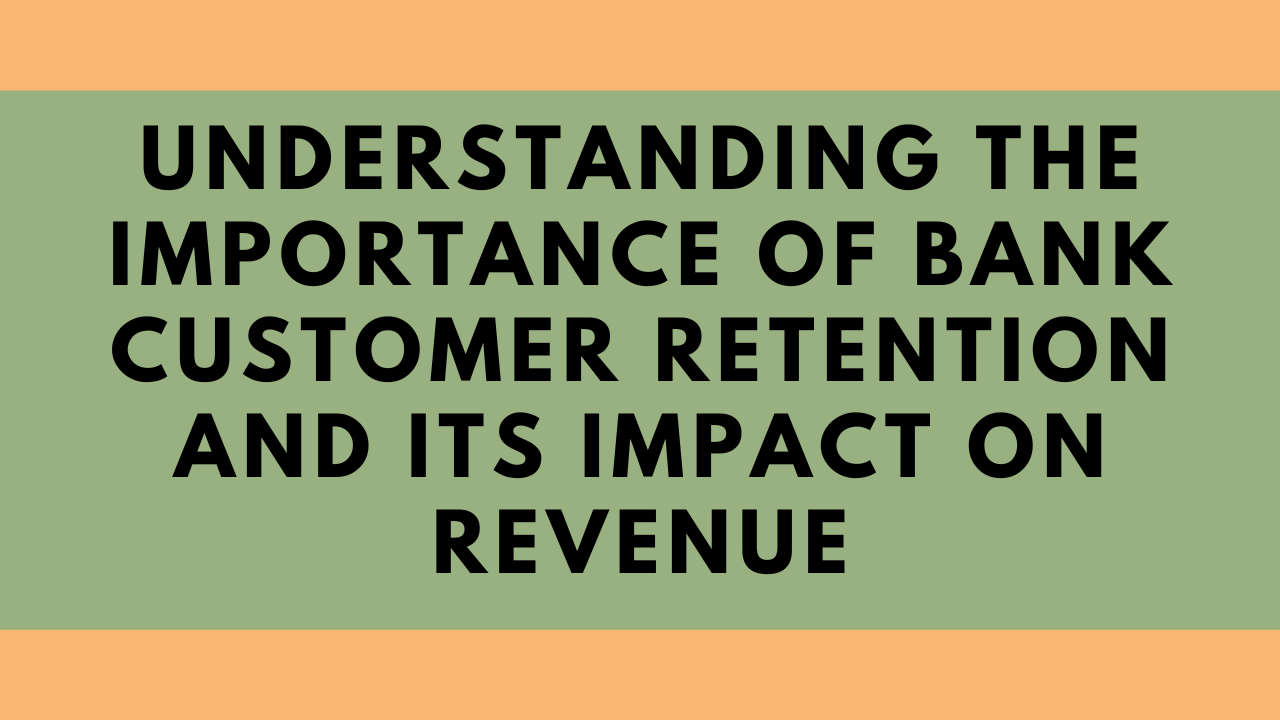Many banks focus their attention on landing new clients with small cash bonuses or higher interest rates on savings accounts, but they’re missing out on a huge source of revenue: their existing customers.
Need proof? Look no further than the shocking events surrounding Silicon Valley Bank and First Republic Bank. Unexpected mass withdrawals threw the banking sector into disarray.
To avoid this dreaded fate, it’s time to invest in customer retention strategies. Keep reading to learn the importance of bank customer retention and how to reduce churn to protect your bottom line.
What Is Bank Customer Retention?
Customer retention is the act of retaining customers instead of losing them to competitors. Many banks focus their attention on landing new clients with small cash bonuses or higher interest rates on savings accounts. However, it is essential to consider the savings account impact when strategizing for customer retention. The opposite of customer retention is called churn.
Generally speaking, customer churn is the natural progression an unsatisfied customer will take until they finally stop doing business with you.
And here’s how you can calculate it:
Churn rate = (Number of Customers at Start of Period−Number of Customers at End of Period) / Number of Customers at Start of Period x 100
For example: If you started with 100 customers at the beginning of the month and ended with 90 customers, then your churn rate would be:
Churn rate = (100 − 90) / 100 × 100 = 10%
Or you can use your financial analytics dashboard to detect churn:
Pro tip: Customer attrition rate is another term for churn rate. The terms “churn” and “attrition” are often used interchangeably.
But it’s key to point out that the goal of customer retention isn’t just to avoid losing paying customers. A more important goal is to improve customer experience.
That way, you can safeguard your company from losing customers to ever-evolving competitors and tarnishing your reputation.
And if you peel back the curtain on the banking industry, recent research shows some shocking details about customer retention issues. For example, half of new customers who churn leave within 90 days of opening their accounts.
And banks usually take at least two years to profit from a customer.
Why Is Customer Retention Important for Banks?
Customer retention is one of the most important facets of running a successful business, much less a bank. So why should you prioritize customer retention strategies? Let’s dive in.
High Customer Retention Validates Successful Marketing
Every year, banks spend billions of dollars on marketing and advertising campaigns.
From an initial glance, one may think these massive investments are worth it when customers are flooding through the door. But this couldn’t be further from the truth.
Large marketing budgets may work wonders to get people in the door. But what about keeping those customers around?
Spending large amounts of money on customer acquisition only to see them walk out the door in 90 days isn’t worth the time or effort. Therefore, prioritizing customer retention helps unlock any marketing campaign’s return on investment (ROI).
It’s Often Difficult to Pinpoint Low Customer Retention Rates
Failing to address customer churn leaves you on the fast track to losing your premium customers to the competition. Think of these customs as the ones you can upsell and cross-sell to.
The result? A significant impact on your bottom line.
But what’s driving this problem in the banking industry? Well, most banks fail to diagnose the reason behind low customer retention rates and customer satisfaction.
Their primary method for customer feedback is blasting out surveys via email. These surveys are plagued with low response rates, usually between 5%-30%.
Here’s an example of a customer feedback survey from U.S. Bank:
We’re all busy people. Who wants to spend 25 minutes sharing feedback that goes right into the internet abyss.
The second issue banks have is relying solely on outdated analytics, such as customer transaction volume. If a historically active customer starts transacting less often, it could signal dissatisfaction or a switch to another banking service.
Although these quantitative measures provide warning signs of high customer churn, it’s increasingly challenging to understand the qualitative measures behind these metrics.
Satisfied Customers Are Great Prospects, Too
Keeping customers satisfied to maintain high profits is only half the equation for banks. The other half is re-entering customers into your sales cycle for upselling, cross-selling, and subscription opportunities.
Here’s an example of a cross-selling offer from SoFi:
Traditionally known in the industry for helping refinance student loans, SoFi offers a wide range of other product and service offerings, too. They house their entire suite of offerings in an innovative mobile app.
To promote these other revenue models (and to sweeten the deal for existing customers), they lean into higher APY and cash bonuses. It’s hard to pass on free money (client gifts and convenience.)
The result? SoFi has over 6 million active members and has helped pay off more than $34 billion in consumer debt.
It goes without saying that the more you engage your customers and provide them with quality products and services, the more likely they’ll be interested in more of what your business offers.
What Are the Reasons Behind Poor Customer Retention Rates?
If you’ve discovered that your bank’s customer attrition rate is higher than normal, there could be a few culprits to blame. Here are the top reasons your customers aren’t sticking around:
- You take too long to respond to customer requests.
- You’re underdelivering on your promises.
- Your customers feel underappreciated.
- You provide bad customer service.
You can constantly engage with customers, take their feedback, and answer their queries to build a strong relationship with customers. A customer service virtual assistant can help you manage all these tasks.
Otherwise, you’ll hurt your reputation and lose customers in the process.
How To Improve Bank Customer Retention
Without further ado, let’s discuss how you can increase customer retention and, therefore, your bottom line.
Offer Personalized Services
Starting a business isn’t a walk in the park. There are plenty of hoops to jump through before opening your doors to paying customers.
And business owners could use all the help they could get. Simple, easy access to business banking solutions is always welcome.
Why? You need a dedicated bank account to accept your first customer payment. LLC owners have distinct financial requirements that differ from personal banking needs.
By offering dedicated business bank accounts to LLC owners, you can effectively cater to these specific customer needs.
It’s also the perfect opportunity to cross-sell to existing customers with personal bank accounts and online banking. That’s where marketing automation software comes into play. It helps you streamline personalized communication and send targeted marketing campaigns.
Get Smart About Crypto
For customers, the allure of crypto lies in novelty and the promise of greater control and efficiency over their money.
As fintech companies continue to offer cryptocurrency-related services, from trading platforms to wallets like Maverick Trading, traditional banks risk losing customers if they don’t adapt.
While the decentralized nature of cryptocurrencies is a key feature, many customers still seek the assurance of a known entity, like a bank, when dealing with such assets.
Banks that can blend new-age finance with old-age trust by offering crypto services, like the declaration of cryptocurrency taxes, will come out on top.
Diversify Your Product or Service Offerings
Fintech is a powerhouse industry backed by billions of dollars in venture capital funds. And there’s no slowing down in sight.
So banks can’t just stick to basic checking accounts (with near-zero interest rates) anymore. Customers, especially Gen Z, seek institutions that offer them a holistic financial toolkit via a mobile app.
Consider the appeal of a detailed Customers Bank savings account guide; if a young adult is trying to navigate the maze of how to pay for college, wouldn’t they be more inclined to stick with a bank that offers resources on student loans, savings accounts specifically designed for college funds, or even seminars on how to find scholarships?
By diversifying offerings with mobile banking, you can cater to a broader audience and ensure that you remain their go-to financial partner as your customers’ financial needs evolve.
Frequently Asked Questions
Why Is Customer Retention in Banking So Challenging?
There’s no definite answer. However, many banks have a hard time pinpointing unsatisfied customers before it’s too late.
What Is the Average Customer Retention Rate for Banks?
The average customer retention rate for banks is 75%.
What Are the Best Ways To Identify Unsatisfied Customers?
Banking and financial services should review customer care logs from recorded calls, emails, and live chat sequences.
Wrap Up
As fintech disrupts traditional banking norms, the key to bank customer retention will be adaptability, innovation, and a relentless focus on delivering value at every turn. In other words, doubling down on customer retention strategies.
Remember, in the age of choice, banking customers will always gravitate towards institutions that anticipate and evolve with their needs. So, it’s time to jump on the bandwagon and improve the banking experience.




















